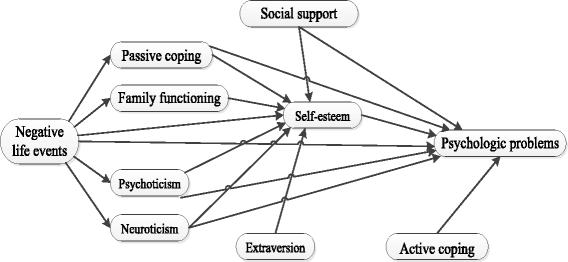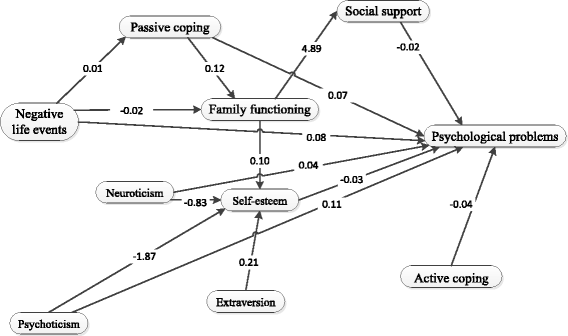The psychological problems and related influential factors of left-behind adolescents (LBA) in Hunan, China: a cross sectional study
- PMID: 28865480
- PMCID: PMC5581416
- DOI: 10.1186/s12939-017-0639-2
The psychological problems and related influential factors of left-behind adolescents (LBA) in Hunan, China: a cross sectional study
Abstract
Background: Due to lack of companionship of parents, compared with non left behind children, left behind children (LBC) suffer from more psychological problems compared with children live with their parents. The aim of this study was to explore the mental health status and the relationship among psychological problems and the related factors of LBC.
Method: Adopting delaminating-random-group sampling and using region, county, village (town) as sampling framework, we utilized Demographic Data Recording Form, Adolescent Self-Rating Life Events Check List, Scale of APGAR, Perceived Social Support Scale, Simplified Coping Style Questionnaire, Eysenck Personality Questionnaire, Self-Esteem Scale and Scale of Mental Health for Chinese Middle-school Student to assess 1309 left behind child in junior middle school students' mental health in Hunan. Statistic description, Structural equation model was adopted to analyze the data.
Result: There was a significant difference in score of psychological problems between LBC and non-LBC(F = 18.224, P<0.000). Life event was the major factor(r = .487) that affected psychological problems (path coefficient, PC = 0.08) directly and affect psychological problems indirectly through affecting passive coping (PC = 0.01)and family functioning(PC = 0.02); family functioning impacted psychological problems indirectly through affecting social support (PC = 4.89) and self-esteem (PC = 0.10); social support (PC = -0.02), passive coping (PC =0.07) and active coping PC = -0.04) affected psychological problems directly. Psychoticism (P) (PC = 0.11), Neuroticism (N) influenced psychological problems of LBC both directly (PC = 0.04) and indirectly through affecting self-esteem (PC: P:-1.87; N: -0.83), while Extraversion/Introversion (E) (PC = 0.21) only impact psychological problems indirectly through self-esteem. Altogether, these variables accounted for 50.2% of total variance of psychological problems (F = 130.470, P = 0.000) for LBC.
Conclusion: In this research we proved that LBC have more sever psychological problems than non-LBC. We also identified the direct and indirect influential factors of psychological problems of LBC. The findings had important implications for prevention policies and interventions to promote mental health of LBC.
Keywords: Adolescent psychiatry; Coping; Family functioning; Life events; Personality; Self-esteem; Social support.
Conflict of interest statement
Ethics approval and consent to participate
Ethical committees from Central South University, the Health Department of Hunan provinces and all five counties have approved the research protocol. Before the data collection, permission of principals and teachers were got from 15 schools and received all informed consent forms from the students included in our research.
Consent for publication
Consent for personal data publication was obtained from the participants and their parents or their grandparents.
Competing interests
The authors declare that they have no competing interests.
Publisher’s Note
Springer Nature remains neutral with regard to jurisdictional claims in published maps and institutional affiliations.
Figures
References
-
- All-China Women’s Federation A Study Report on the Situation of Left - behind Children and Migrant Children in Rural and Urban Areas in China. 2013. Available at:(http://acwf.people.com.cn/n/2013/0510/c99013-21437965.html)
-
- Zhou FL, Duan CR. Reviews of studies of left behind children. Popul J. 2006;3:60–65.
-
- Zhong Y, Zhong Z, Pan J, Li Q, Zhong Y, Sun H. Research on child neglect situation and influential factors of left behind children and living- with- parents children aged 6-17 year-old in rural areas of two provinces, western China. Chin J Prev Med. 2015;49(10):873–878. - PubMed
MeSH terms
LinkOut - more resources
Full Text Sources
Other Literature Sources
Medical



